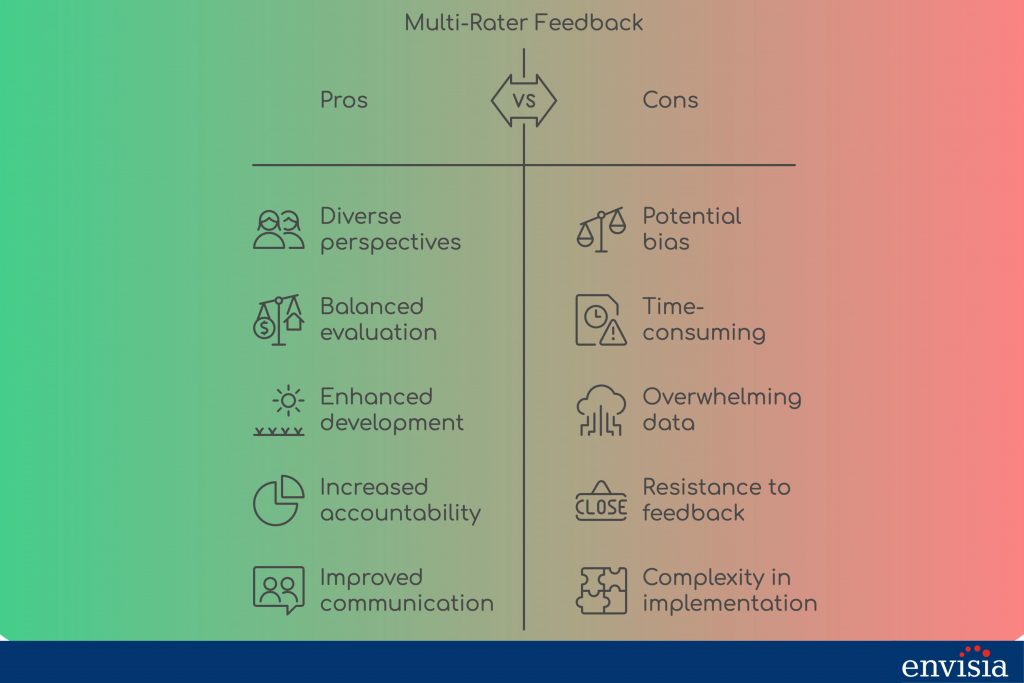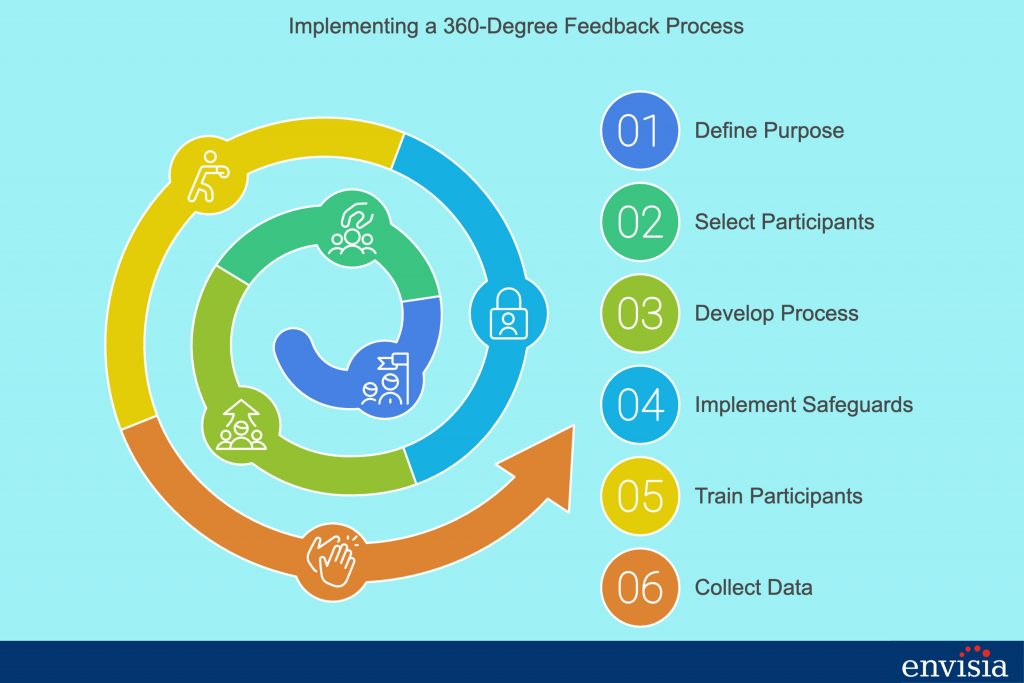In today’s fast-paced business environment, organizations are constantly seeking effective ways to enhance employee performance and foster a culture of continuous improvement. Yet, many struggle with traditional performance reviews that often fail to provide a holistic view of performance, leaving employees and managers wanting more actionable feedback. If you’ve ever felt that your current evaluation methods aren’t capturing the full picture, you’re not alone.
The challenge lies in gathering comprehensive feedback that not only identifies areas for improvement but also leverages strengths to promote personal and professional growth. Without a robust feedback process, valuable opportunities for employee development can be missed, affecting the organization’s overall performance.
But there’s a powerful tool that can transform your performance management system: implementing a 360-degree evaluation process. In this article, we’ll explore best practices for successful implementation, helping you create constant advancement and maximize your team’s potential.
Key Takeaways
- Understanding the value of 360-degree feedback and how it provides a holistic view of performance.
- Step-by-step guidance on successfully implementing a 360-degree feedback program in your organization.
- Best practices to ensure your evaluation procedure is effective, practical, and fosters continuous improvement.

Introduction to 360 Degree Feedback
What is 360 Degree Feedback?
In an ever-evolving workplace, traditional performance evaluations often fall short in providing a comprehensive understanding of an employee’s performance. 360-degree feedback is a powerful tool that gathers feedback from multiple sources, including peers, subordinates, supervisors, and even external stakeholders.
This multisource feedback approach provides a holistic view of performance, highlighting both strengths and performance gaps. By incorporating diverse perspectives, organizations can tailor development plans that truly address the needs of the employee.
Why Use Multi-Source Feedback in Performance Management?
Implementing a 360-degree feedback process in your performance management system offers numerous benefits. It promotes a culture of perpetual development and open communication, allowing team members to give and receive constructive feedback effectively. This process enhances self-awareness, supports leadership development, and aligns individual development goals with organizational objectives.
By providing valuable feedback from various perspectives, employees can better understand their impact on the company’s performance and engage in meaningful personal and professional growth.
Common Use Cases for 360 Feedback in Organizations
Organizations often choose to implement multi-source feedback when they want to enhance their performance management tool or when traditional performance reviews aren’t providing sufficient insights. It’s particularly useful for leadership development, talent development, and when aiming to create a culture of continuous improvement.
By collecting feedback from multiple sources, employees may gain a better understanding of their job performance, while managers can use the feedback to tailor coaching and development plans. This comprehensive approach can reduce the time spent on performance evaluations and improve overall performance.

Benefits and Drawbacks of Multi-Rater Feedback
Pros of Multi-Rater Feedback
Holistic Performance Insights: How 360-degree feedback provides a well-rounded view.
The 360-degree feedback system offers a comprehensive perspective on an employee’s performance from various angles. This approach ensures that feedback isn’t solely based on a manager’s viewpoint but includes input from peers, subordinates, and other stakeholders. Such a system can identify strengths and weaknesses more effectively, leading to more actionable development plans.
Enhanced Self-Awareness and Identifying Blind Spots for Team Members
By receiving feedback from multiple sources, employees can become more self-aware, recognizing blind spots that might not surface in traditional reviews. This self-awareness is crucial for personal and professional growth, helping team members to improve performance and contribute more effectively to the organization.
Improved Team Dynamics and Collaboration
When employees give and receive feedback openly, it fosters better communication and collaboration within teams. This process can strengthen relationships, enhance trust, and contribute to a more cohesive working environment.
Motivation and Engagement through Ongoing Development
Regular 360-degree reviews can motivate employees by highlighting areas for improvement and recognizing achievements. This ongoing feedback loop keeps employees engaged and aligned with the company’s goals, promoting an environment of continuous performance improvement.
Cons of 360 Degree Feedback
Bias and Inaccuracy: Addressing Common Biases in Feedback
One potential drawback of the 360-degree feedback process is the possibility of bias. Feedback may be influenced by personal relationships or misunderstandings, leading to inaccurate evaluations. Ensuring anonymity and training participants on providing effective feedback can mitigate these issues.
Data Overload and Feedback Overwhelm
Collecting a large volume of feedback data can be overwhelming for both employees and managers. Without proper tools and processes, it’s challenging to distill actionable insights from the information gathered.
Time and Resource Demands: Ensuring Feedback is Constructive and Manageable
Implementing a multi-source review process requires significant time and resources. From training participants to analyzing feedback, the process can be demanding. However, with careful planning and the use of appropriate technology, these challenges can be reduced.
Fear of Retaliation and Anonymity Concerns
Employees might hesitate to provide honest feedback due to fear of negative repercussions. Ensuring confidentiality and that participants feel safe is essential for the success of the program.

Essential Steps to Successfully Implement Feedback
Step 1: Define the Purpose of Your Feedback Process
Before launching a 360-degree feedback program, clarify whether the primary goal is employee development, performance review, or both. Understanding what you want to accomplish helps align the process with your organization’s values and competencies. Clearly defined objectives ensure that the feedback collected is relevant and practical.
Step 2: Select Appropriate Participants and Reviewers
Choose the right mix of raters, including peers, direct reports, supervisors, and other relevant stakeholders. This selection ensures that feedback is balanced and comprehensive. Consider limiting the number of reviewers to reduce the time burden on participants while still providing valuable insights.
Step 3: Develop a Structured Feedback Process
Establish a clear and consistent feedback process for collecting feedback. Decide whether the feedback will be anonymous to encourage honesty and ensure participants feel safe. Set timelines and deadlines to keep the process on track, and communicate these clearly to all involved.
Step 4: Implement Confidentiality and Anonymity Safeguards
Protecting privacy is crucial to foster open and honest feedback. Implement measures to ensure that individual responses cannot be traced back to the respondents. Communicate these safeguards clearly to build trust in the process.
Step 5: Train Participants on Giving and Receiving 360-Degree Feedback
Provide training to employees on how to give constructive feedback and how to receive feedback gracefully. This training can improve the quality of feedback received and ensure that participants understand the purpose and benefits of the process.
Step 6: Collect and Analyze Feedback Data
Use reliable tools or software to gather and analyze feedback data efficiently. This technology can help compile the information into comprehensive reports that highlight key trends and areas for improvement.
Step 7: Conduct Feedback Discussions and Create Action Plans
Managers should meet with employees to discuss the feedback and collaboratively develop development plans. These plans should be tailored to the individual’s needs, focusing on both strengths and areas for improvement. This step ensures that the feedback leads to implementable steps for growth.
Step 8: Follow Up and Measure Success in the Review Process
Regular follow-ups are essential to monitor progress and reinforce the importance of the 360-degree review process. Use metrics to assess improvements in performance and adjust the process as needed to ensure it continues to meet the organization’s goals.
Best Practices for 360 Feedback in Organizations
Align the Feedback Process with Organizational Goals
Ensure that the 360 feedback process is directly connected to the organization’s objectives and competencies. This alignment makes the feedback more relevant and ensures that it supports the company’s performance and strategic direction.
Establish Consistency in the 360 Feedback Process
Set a regular schedule for 360-degree feedback sessions, whether annually or more frequently. Consistency helps embed the process into the organizational culture and reinforces its importance in performance management.
Integrate Technology for Seamless 360 Feedback
Leverage digital solutions for leaders, such as specialized software, to manage the 360 review feedback process efficiently. These tools can reduce administrative burdens, improve confidentiality, and provide valuable analytics to enhance the feedback program.
Provide Constructive, Actionable Feedback
Train participants to give specific, behavior-focused feedback rather than personal critiques. Emphasize the importance of providing actionable feedback that can lead to improvement and development. This approach makes the feedback more effective and beneficial for the employee.
Ensure Leadership and Management Buy-In for Feedback
Leadership is key to the success of any feedback implementation. Secure commitment from senior management to champion the 360-degree feedback initiative. Their support can create a culture where feedback is valued and integrated into daily practices.
Purpose and Objectives
- Is this feedback for development, evaluation, or both?
- What specific outcomes does the organization hope to achieve?
Participant Selection and Scope
- Who will give and receive feedback?
- Should the feedback be limited to certain roles or departments?
Confidentiality and Anonymity
- Will feedback be anonymous?
- How will the organization ensure discretion and privacy?
Tools and Technology
- What platform or tools will you use to collect and analyze feedback?
Follow-Up and Action Planning
- What steps will be taken to address feedback?
- How will the organization measure success in implementing 360-degree feedback?

Conclusion: Making 360 Feedback a Powerful Tool for Performance Management
In summary, 360-degree feedback provides a comprehensive view of an employee’s performance, offering valuable insights that traditional methods might miss. By following best practices and ensuring a successful implementation, organizations can enhance their performance management systems and nurture a culture of continuous improvement.
Key to this process is clarity, consistency, and follow-up. Aligning the feedback process with structural goals, ensuring privacy, and providing actionable feedback are all essential components. Remember, leadership support and effective communication can make all the difference in the success of your 360-degree feedback initiative.
We encourage organizations to revisit and refine their 360-degree feedback process regularly. By doing so, you can tailor the program to meet evolving needs, ensuring it remains a valuable tool for both employee development and overall organizational success.
